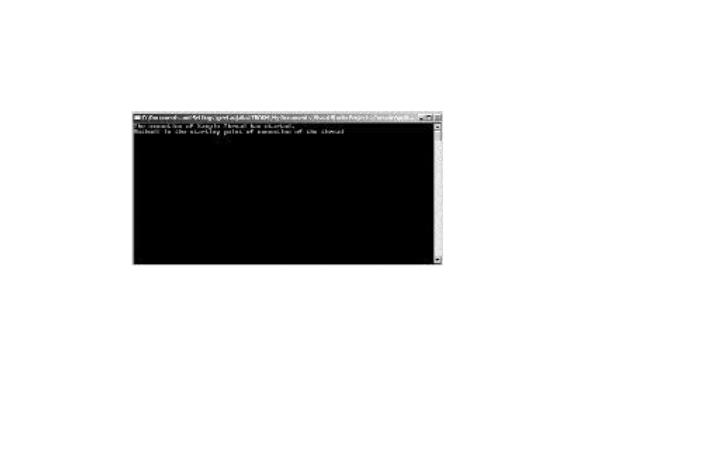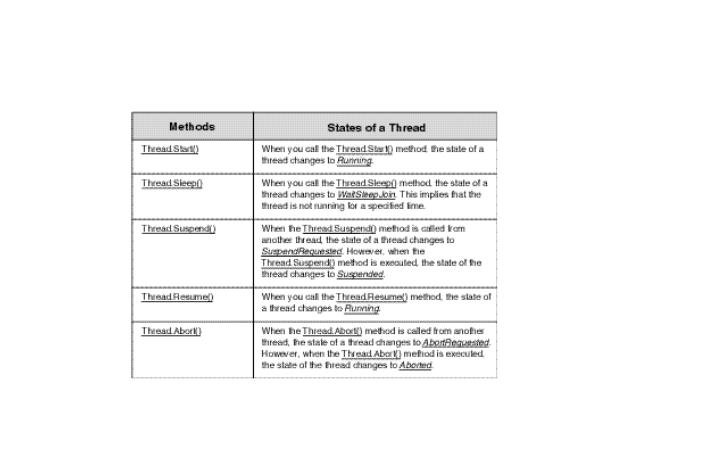
- •About the Authors
- •Contents at a Glance
- •Contents
- •Introduction
- •Goal of the Book
- •How to Use this Book
- •Introduction to the .NET Framework
- •Common Language Runtime (CLR)
- •Class Library
- •Assembly
- •Versioning
- •Exceptions
- •Threads
- •Delegates
- •Summary
- •Introduction to C#
- •Variables
- •Initializing Variables
- •Variable Modifiers
- •Variable Data Types
- •Types of Variables
- •Variable Scope
- •Types of Data Type Casting
- •Arrays
- •Strings
- •Initializing Strings
- •Working with Strings
- •Statements and Expressions
- •Types of Statements
- •Expressions
- •Summary
- •Classes
- •Declaring Classes
- •Inheritance
- •Constructors
- •Destructors
- •Methods
- •Declaring a Method
- •Calling a Method
- •Passing Parameters to Methods
- •Method Modifiers
- •Overloading a Method
- •Namespaces
- •Declaring Namespaces
- •Aliases
- •Structs
- •Enumerations
- •Interfaces
- •Writing, Compiling, and Executing
- •Writing a C# Program
- •Compiling a C# Program
- •Executing a C# Program
- •Summary
- •Arrays
- •Single-Dimensional Arrays
- •Multidimensional Arrays
- •Methods in Arrays
- •Collections
- •Creating Collections
- •Working with Collections
- •Indexers
- •Boxing and Unboxing
- •Preprocessor Directives
- •Summary
- •Attributes
- •Declaring Attributes
- •Attribute Class
- •Attribute Parameters
- •Default Attributes
- •Properties
- •Declaring Properties
- •Accessors
- •Types of Properties
- •Summary
- •Introduction to Threads
- •Creating Threads
- •Aborting Threads
- •Joining Threads
- •Suspending Threads
- •Making Threads Sleep
- •Thread States
- •Thread Priorities
- •Synchronization
- •Summary
- •Case Study
- •Project Life Cycle
- •Analyzing Requirements
- •High-Level Design
- •Primary and Foreign Keys
- •Referential Integrity
- •Normalization
- •Designing a Database
- •Low-Level Design
- •Construction
- •Integration and Testing
- •User Acceptance Testing
- •Implementation
- •Operations and Maintenance
- •Summary
- •Creating a New Project
- •Console Application
- •Windows Applications
- •Creating a Windows Application for the Customer Maintenance Project
- •Creating an Interface for Form1
- •Creating an Interface for WorkerForm
- •Creating an Interface for CustomerForm
- •Creating an Interface for ReportsForm
- •Creating an Interface for JobDetailsForm
- •Summary
- •Performing Validations
- •Identifying the Validation Mechanism
- •Using the ErrorProvider Control
- •Handling Exceptions
- •Using the try and catch Statements
- •Using the Debug and Trace Classes
- •Using the Debugging Features of Visual Studio .NET
- •Using the Task List
- •Summary
- •Creating Form1
- •Connecting WorkerForm to the Workers Table
- •Connecting CustomerForm to the tblCustomer Table
- •Connecting the JobDetails Form
- •to the tblJobDetails Table
- •Summary
- •Introduction to the Crystal Reports Designer Tool
- •Creating the Reports Form
- •Creating Crystal Reports
- •Creating the Windows Forms Viewer Control
- •Creating the Monthly Worker Report
- •Summary
- •Introduction to Deploying a Windows Application
- •Deployment Projects Available in Visual Studio .NET
- •Deployment Project Editors
- •Summary
- •Case Study
- •Project Life Cycle
- •Analyzing Requirements
- •High-Level Design
- •Low-Level Design
- •Summary
- •Populating the TreeView Control
- •Displaying Employee Codes in the TreeView Control
- •Event Handling
- •Displaying Employee Details in the ListView Control
- •Summary
- •Case Study
- •Project Life Cycle
- •Analyzing Requirements
- •High-Level Design
- •Low-Level Design
- •Summary
- •Adding the Programming Logic to the Application
- •Adding Code to the Form Load() Method
- •Adding Code to the OK Button
- •Adding Code to the Exit Button
- •Summary
- •The Created Event
- •Adding Code to the Created Event
- •Overview of XML
- •The XmlReader Class
- •The XmlWriter Class
- •Displaying Data in an XML Document
- •Displaying an Error Message in the Event Log
- •Displaying Event Entries from Event Viewer
- •Displaying Data from the Summary.xml Document in a Message Box
- •Summary
- •Airline Profile
- •Role of a Business Manager
- •Role of a Network Administrator
- •Role of a Line-of-Business Executive
- •Project Requirements
- •Creation and Deletion of User Accounts
- •Addition of Flight Details
- •Reservations
- •Cancellations
- •Query of Status
- •Confirmation of Tickets
- •Creation of Reports
- •Launch of Frequent Flier Programs
- •Summarizing the Tasks
- •Project Design
- •Database Design
- •Web Forms Design
- •Enabling Security with the Directory Structure
- •Summary
- •Getting Started with ASP.NET
- •Prerequisites for ASP.NET Applications
- •New Features in ASP.NET
- •Types of ASP.NET Applications
- •Exploring ASP.NET Web Applications
- •Introducing Web Forms
- •Web Form Server Controls
- •Configuring ASP.NET Applications
- •Configuring Security for ASP.NET Applications
- •Deploying ASP.NET Applications
- •Creating a Sample ASP.NET Application
- •Creating a New Project
- •Adding Controls to the Project
- •Coding the Application
- •Summary
- •Creating the Database Schema
- •Creating Database Tables
- •Managing Primary Keys and Relationships
- •Viewing the Database Schema
- •Designing Application Forms
- •Standardizing the Interface of the Application
- •Common Forms in the Application
- •Forms for Network Administrators
- •Forms for Business Managers
- •Forms for Line-of-Business Executives
- •Summary
- •The Default.aspx Form
- •The Logoff.aspx Form
- •The ManageUsers.aspx Form
- •The ManageDatabases.aspx Form
- •The ChangePassword.aspx Form
- •Restricting Access to Web Forms
- •The AddFl.aspx Form
- •The RequestID.aspx Form
- •The Reports.aspx Form
- •The FreqFl.aspx Form
- •Coding the Forms for LOB Executives
- •The CreateRes.aspx Form
- •The CancelRes.aspx Form
- •The QueryStat.aspx Form
- •The ConfirmRes.aspx Form
- •Summary
- •Designing the Form
- •The View New Flights Option
- •The View Ticket Status Option
- •The View Flight Status Option
- •The Confirm Reservation Option
- •Testing the Application
- •Summary
- •Locating Errors in Programs
- •Watch Window
- •Locals Window
- •Call Stack Window
- •Autos Window
- •Command Window
- •Testing the Application
- •Summary
- •Managing the Databases
- •Backing Up the SkyShark Airlines Databases
- •Exporting Data from Databases
- •Examining Database Logs
- •Scheduling Database Maintenance Tasks
- •Managing Internet Information Server
- •Configuring IIS Error Pages
- •Managing Web Server Log Files
- •Summary
- •Authentication Mechanisms
- •Securing a Web Site with IIS and ASP.NET
- •Configuring IIS Authentication
- •Configuring Authentication in ASP.NET
- •Securing SQL Server
- •Summary
- •Deployment Scenarios
- •Deployment Editors
- •Creating a Deployment Project
- •Adding the Output of SkySharkDeploy to the Deployment Project
- •Deploying the Project to a Web Server on Another Computer
- •Summary
- •Organization Profile
- •Project Requirements
- •Querying for Information about All Books
- •Querying for Information about Books Based on Criteria
- •Ordering a Book on the Web Site
- •Project Design
- •Database Design
- •Database Schema
- •Web Forms Design
- •Flowcharts for the Web Forms Modules
- •Summary
- •Introduction to ASP.NET Web Services
- •Web Service Architecture
- •Working of a Web Service
- •Technologies Used in Web Services
- •XML in a Web Service
- •WSDL in a Web Service
- •SOAP in a Web Service
- •UDDI in a Web Service
- •Web Services in the .NET Framework
- •The Default Code Generated for a Web Service
- •Testing the SampleWebService Web Service
- •Summary
- •Creating the SearchAll() Web Method
- •Creating the SrchISBN() Web Method
- •Creating the AcceptDetails() Web Method
- •Creating the GenerateOrder() Web Method
- •Testing the Web Service
- •Securing a Web Service
- •Summary
- •Creating the Web Forms for the Bookers Paradise Web Site
- •Adding Code to the Web Forms
- •Summary
- •Case Study
- •Project Life Cycle
- •Analyzing Requirements
- •High-Level Design
- •Low-Level Design
- •Summary
- •Overview of Mobile Applications
- •The Microsoft Mobile Internet Toolkit
- •Overview of WAP
- •The WAP Architecture
- •Overview of WML
- •The Mobile Web Form
- •The Design of the MobileTimeRetriever Application
- •Creating the Interface for the Mobile Web Forms
- •Adding Code to the MobileTimeRetriever Application
- •Summary
- •Creating the Forms Required for the MobileCallStatus Application
- •Creating the frmLogon Form
- •Creating the frmSelectOption Form
- •Creating the frmPending Form
- •Creating the frmUnattended Form
- •Adding Code to the Submit Button in the frmLogon Form
- •Adding Code to the Query Button in the frmSelectOption Form
- •Adding Code to the Mark checked as complete Button in the frmPending Form
- •Adding Code to the Back Button in the frmPending Form
- •Adding Code to the Accept checked call(s) Button in the frmUnattended Form
- •Adding Code to the Back Button in the frmUnattended Form
- •Summary
- •What Is COM?
- •Windows DNA
- •Microsoft Transaction Server (MTS)
- •.NET Interoperability
- •COM Interoperability
- •Messaging
- •Benefits of Message Queues
- •Limitations
- •Key Messaging Terms
- •Summary
- •Pointers
- •Declaring Pointers
- •Types of Code
- •Implementing Pointers
- •Using Pointers with Managed Code
- •Working with Pointers
- •Compiling Unsafe Code
- •Summary
- •Introduction to the Languages of Visual Studio .NET
- •Visual C# .NET
- •Visual Basic .NET
- •Visual C++ .NET
- •Overview of Visual Basic .NET
- •Abstraction
- •Encapsulation
- •Inheritance
- •Polymorphism
- •Components of Visual Basic .NET
- •Variables
- •Constants
- •Operators
- •Arrays
- •Collections
- •Procedures
- •Arguments
- •Functions
- •Adding Code to the Submit Button
- •Adding Code to the Exit Button
- •Summary
- •Introduction to Visual Studio .NET IDE
- •Menu Bar
- •Toolbars
- •Visual Studio .NET IDE Windows
- •Toolbox
- •The Task List Window
- •Managing Windows
- •Customizing Visual Studio .NET IDE
- •The Options Dialog Box
- •The Customize Dialog Box
- •Summary
- •Index

102 |
Part II |
HANDLING DATA |
|
|
|
FIGURE 6-2 Output of the previous code
When you call the methods of the Thread class, the state of the thread changes. For example, before you start a thread, the thread is not running. After you call the Start() method, the state of the thread changes to Running. This state changes further when you call the Suspend() or Abort() methods. In other words, whenever you perform an action on the thread, its state changes. The next section discusses the various states of a thread in detail.
Thread States
The change in the state of a thread results from the action performed on the thread. In other words, when you call a method of the Thread class, it changes the state of the thread. Figure 6-3 shows the effect of various methods of the Thread class on the states of a thread.
You have seen that you can suspend, sleep, or abort a running thread. However, if you do not want any other user to change the state of your thread, you can set the priority of your thread to Highest. The following section discusses thread priorities in detail.
Thread Priorities
The thread priorities define the sequence of executing various threads on a system. For example, if you have two threads running on a system, the thread with higher priority is executed first. C# allows you to set different priorities for different threads running simultaneously on your system.

THREADS |
Chapter 6 |
103 |
|
|
|
FIGURE 6-3 Effect of methods on the states of a thread
The priority levels supported by C# are as follows:
Highest. A thread with the Highest priority is executed first. When the C# compiler finds the thread with the Highest priority, it stops executing all other threads until the thread with the Highest priority is executed.
AboveNormal. A thread with the AboveNormal priority is executed before any other threads except the thread with the Highest priority.
Normal. A thread with the Normal priority is third in the priority list. This thread is given a time slice according to the process of preemptive multitasking.
BelowNormal and Lowest. A thread with the BelowNormal or Lowest priority is executed only if the operating system does not encounter any other thread with a higher priority. You normally assign these priority levels to threads whose execution is not important to the system.
All of the priority levels mentioned here are a part of an enumeration object
known as ThreadPriorityEnumeration.
You can see that the priority levels can be set to define the sequence of execution of threads. However, the priority levels that you set are only applicable to the

104 |
Part II |
HANDLING DATA |
|
|
|
threads of a single process. For example, if you have a multithreaded application with five threads, the sequence in which these threads will be executed is affected by the priority levels. A thread with a higher priority does not affect the execution of threads of another application running on the system.
You can change the priority of a thread by specifying the value in the ThreadPriority property of the thread. To understand the syntax of the ThreadPriority property, look at the following example:
Thread Thread1 = new Thread(new ThreadStart(newClass.Method1));
Thread1.Priority = ThreadPriority.Highest;
The previous code sets the priority of Thread1 as Highest. This stops the execution of all the threads with a lower priority level until Thread1 is executed.
CAUTION
You should be very careful while setting priorities because specifying a priority level of Highest stops the execution of all the threads running on a system.
You have seen that by specifying the priority level of threads, you can set the sequence of executing multiple threads on your system. In addition to setting the priority levels, you need to synchronize multiple threads.This ensures smooth and bug-free execution of multiple threads simultaneously. The next section will help you understand the concept of synchronization so that the operating system does not encounter any problems while executing multithreaded applications.
Synchronization
As the name suggests, synchronization helps you to synchronize the use of variables and objects accessed by multiple threads running on your system. In simpler words, synchronization ensures that a variable can be accessed by only one thread at a time. Therefore, by preventing multiple threads from accessing a single variable, you can ensure bug-free execution of the threads on your system.
To understand the need for synchronization, consider a scenario in which two threads with the same priority, thread1 and thread2, are running simultaneously on a system. When the first thread is executed in its time slice, it may write some value to a public variable, variable1. However, in the next time slice, the other

THREADS |
Chapter 6 |
|
105 |
|
|||
|
|
|
|
thread might try to read or write a value to variable1. This situation can result in an error if the process of writing a value to variable1 is not completed in the first time slice. When another thread reads this variable, it may read the w rong value, resulting in an error. This situation can be avoided by synchronizing the use of variable1 by only one thread.
C# provides you with the lock keyword to synchronize the use of variables and objects. The lock statement takes the name of the object or variable to be locked as a parameter by the lock keyword. The name of the variable is enclosed in parentheses as shown in the following example:
lock (variable1)
{
------------
}
Here, variable1 is the name of the variable to be locked by a thread. The statements to be executed after placing a lock on variable1 are enclosed in curly braces following the lock statement. The lock statement locks the variable so that no other thread can access it for the time the lock is placed on the variable. To do this, the lock statement places an object known as mutual exclusion lock or mutex on the variable. No other thread is given access to a variable for the time mutex is placed on the variable.
Therefore, if thread1 places a lock or mutex on variable1, the operating system puts thread2 on sleep for the time mutex is placed on variable1.
By now, you know that synchronization is essential to prevent bugs in your multithreaded application. However, excessive synchronization might reduce the performance of your application. Now, look at the problems associated with the use of excessive synchronization.
When you place a lock on an object, no other thread is allowed to access this object. Therefore, any other thread that needs access to this object waits for the other thread to release the lock. If there are several threads waiting for the thread to release the lock, the overall performance of the application is affected. The performance of the application can be balanced to some extent by placing locks effectively. The lock on the object is placed for the time the compiler executes the statements in the lock block. Therefore, if you write minimum code in the lock statement, you can minimize the effect of placing a lock on a variable by an application.
